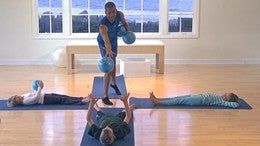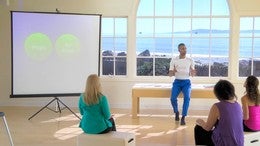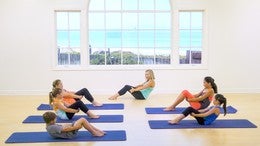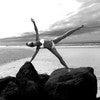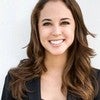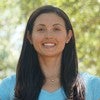Description
If you are interested in working with children, the Pilates for Children and Adolescents; Manual of Guidelines and Curriculum is highly recommended before you start a program.
About This Video
Transcript
Read Full Transcript
Hi, my name is dawn Marie iccs and I am a physical therapist and a pilates instructor. And I'm going to talk to you today a little bit about [inaudible] and children and some of the things to consider when looking at how you might pick an appropriate program for whether it's your child or maybe you want to teach a children's class in your studio. And before I get started with listing some things that will help, uh, organize really your approach to that. I want to talk a little bit about why [inaudible] is for children as opposed to yoga or other types of organized fitness. And, uh, this goes back to as a parent and applaud instructor years ago, looking at options for my kids at their school when they didn't have access to a lot of different things with physical education. So we started looking at, uh, how could we create a structure that wouldn't necessarily have to be taught by myself or someone who say had an extended educational background in working with kids, but they could safely choose certain exercises that were appropriate for specific needs for children. So one of the questions I get quite a bit from parents is, okay, I've read an article or I have a friend whose child does polities and I want to do it with my daughter or my son. And I have no idea where to start.
I've never personally done studies myself and I don't even know how to go about selecting the right place to do it. Or if I can't drive to your studio, I get calls from all over the country. And one of the things that I talk to parents about quite a bit is, uh, before we start getting into how old are your kids really, is what are your kids really into? What do they enjoy? Do they like organized sports? Do they like focused activities, training, taekwondo, et Cetera? Or do they tend to be a less physical person? And maybe that is the motivation they want to get them more physical or more active, because that really makes a difference in the types of programming you'll choose and how you'll go about selecting the right instructor or the right studio or the right classes for your child.
So that's the first thing you want to look at is what are they into? So the second consideration is the age of your child. So I have had children as little as three participate in a [inaudible] class for five to eight year olds just by default. They're the little brother, the little sister of one of the other children in a class. There really are some important considerations in my classes. I'm trained to work with small children both as a pediatric physical therapist and as a pilates instructor. So it's a little bit different, but the typical age that kids can start participating in [inaudible] based movements and plays based classes is anywhere between five and nine years old.
That's kind of the first younger group. Then we move into what's called the magic window, which is a group of uh, age ranges that go from about nine to 13 and that is the optimal place for most studios to start. So if you're looking for a studio and you are not sure what the age ranges are, obviously call and ask them, but chances are they're going to start in that magic window range. With the types of classes that they offer because that's a very easy starting point and it's actually the most optimal point in childhood development to start introducing piles based movements and exercises. You can do it with the younger kids, but it's a little bit more challenging to manage.
A lot of teachers have talked about the challenges of working with really small children in a studio environment. So that magic window range is sometimes an easier place to start. So most studios that I know of, if they're doing a place for kids class, that's about the range of the kids that participate. But in your local area it might be different. So if you are looking into a local studio and you know there's a teacher there that teaches a place for children's program, the third thing you really want to look at is what are the goals of what you want to have your child get out of that program and what are maybe some of their challenges.
And that's where the background and education of the person who's actually teaching the Polonius for kids class can really come in handy if your student or child has a particular sports focus or emphasis that they want to improve upon. You really want to look at, okay, has this person had extended training in say dance injury prevention or dance conditioning for young people. That's, that's one route you can go. The other thing you want to look at is is the type of program that's at that facility one that is more of a structured Mat Pilati is for children program or is it kind of an unstructured, more free flowing creative movement because there's a lot of variability in how people were s will structure their classes as well. Right now there is no standardized quote unquote certification for being trained to work with children. We recommend that you buy the guidelines book because obviously it has all of the specific safety and age appropriate developmental guidelines for working with children and any polities instructor can pick up that book and apply very important information that can create a cell, a safe and healthy environment.
For your child. Another thing I want to point out though is much of what is already outlined in map glottis that's effective for each of these different groups of kids. Doesn't have to have additions to it beyond the Peloton repertoire. A lot of times we think of exercise and movement classes for children as having lots of fancy props and scarves and you know visually stimulating things and those are wonderful and great and can be very creative with class programming as well but is in its most basic form. The map maladies we've identified is really effective for kids and I find that they really value the simplistic nature of keeping the exercises true to how they were originally designed.
We just have to add and delete certain exercises based on the age group. Another question that comes up quite frequently with working with children is how do you adapt or how do you determine how to best work with children with special needs and that can be a little tricky. I won't lie. It can be challenging. It does require specific training. If you're going to be working with children that have low function with particular diagnoses, it's really appropriate for them to be monitored by a health care team, et cetera. But there are a lot of diagnoses in special pop, what we call special populations that don't quite require that level of medical supervision or health team supervision. And W for example, one of those areas that I have a lot of instructors that work with is autism and autism is a spectrum disorder. So there is a gamut of behaviors you'll see in children with autism.
But one of the things that PyLadies provides that is so effective, and I hear it time and time and time again from teachers, parents, occupational therapists, physical therapists, is the nature of the repetition. And the sequencing with the breath taps into an inherent desire for a lot of these kids to be participating in activities that are repetitive. It's part of how they upregulate and downregulate their nervous systems. So that's one of the first things I say when someone says my child has autism. I don't know if Polonius is appropriate for them.
They have to try it first and foremost because every child is different, but there's a huge opportunity with that group. The other thing to consider with any of the gamut of other diagnoses that children can be dealing with is Peloton optimizes brain function because it improves circulation, it improves breath, it improves body awareness, and all of those things have an impact on a child's developing brain and their brain chemistry. So they're more relaxed, they're calmer, they modulate stress differently, and that that's helpful in any case who can't benefit from breathing, who can't benefit from being more relaxed, especially kids that are dealing with a lot of other physical or cognitive challenges in their development. So as you may have gathered, this is a really big topic and we could talk for hours. Me, I could talk for days, but we could talk for a long time on the subject of Palladio's and all of its amazing benefits for children. But just to recap what we're looking at. First thing is just look at what is your child like to do or what do you intend to do as a studio owner? What children do you want to tap into? Do you want to work with sports teams? Do you want to focus on special needs? Depending on what it is, you can identify additional training, you could get support, et cetera.
I am happy to help anyone out there that has questions. You can contact me through the forum. You can email me@dmixatellahealth.com with questions or question through the forum and we can answer them. That's a really effective way for more people to see what you, the viewers are wanting to know answers to and then hopefully help how people progress, uh, with their plans for working with PyLadies for children. And the most important thing is to appreciate that inherently [inaudible] mat work and the mat work that's appropriate for these age groups really impacts kids without a lot of bells and whistles.
The Bells and whistles are a wonderful addition. But just starting with the standard map, Palladia is program based on the guidelines that are in print and publication. You could really create tools and habits that kids can use for the rest of their lives. And really impact their health and wellbeing. I look forward to hearing from you on polities anytime and I hope you enjoy the next pieces we have to come.
Comments
You need to be a subscriber to post a comment.
Please Log In or Create an Account to start your free trial.
